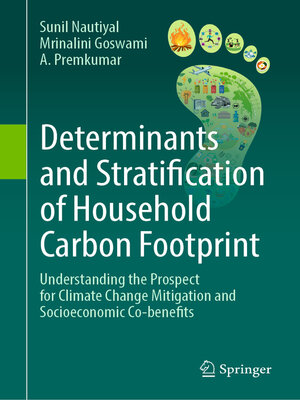Determinants and Stratification of Household Carbon Footprint
ebook ∣ Understanding the Prospect for Climate Change Mitigation and Socioeconomic Co-benefits
By Sunil Nautiyal

Sign up to save your library
With an OverDrive account, you can save your favorite libraries for at-a-glance information about availability. Find out more about OverDrive accounts.
Find this title in Libby, the library reading app by OverDrive.



Search for a digital library with this title
Title found at these libraries:
| Library Name | Distance |
|---|---|
| Loading... |
This book provides comprehensive insights into the socioeconomic systems, carbon accounting, and consumption-expenditure frameworks influencing household carbon footprints (HCF) in a developing economy. It offers a unique perspective on the link between socioeconomic classes, agro-ecological zones, and carbon emissions, specifically in the Indian context.
Household consumption patterns play a critical role in determining greenhouse gas emissions and are increasingly recognized as vital for shaping effective climate policies. Various socio-economic, demographic, and lifestyle factors—such as household size, income, food habits, mobility choices, waste management practices, home appliances, and education—significantly impact HCF. While the IPCC mitigation framework focuses extensively on direct emissions from energy and product production, this book emphasizes indirect emissions driven by lifestyle choices and end-use consumption. The book is based on a PAN-India study across 13 diverse locations within nine agro-ecological regions, examining the socioeconomic and geo-climatic determinants of household carbon emissions. It explores the income-consumption relationship, providing strategies to leverage these insights for targeted decarbonization and sustainable development. Additionally, the book addresses the behavioral aspects of carbon footprints and offers policy recommendations to promote a "carbon handprint"—advocating for carbon-friendly behaviors and solutions that are socially acceptable. By segregating emissions from production and consumption, it aims to guide the development of comprehensive emission reduction strategies for various consumables.
This volume is an essential resource for students, researchers, and policymakers interested in sustainable consumption, climate mitigation, and the socio-economic dimensions of carbon emissions in developing countries.







